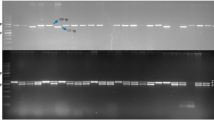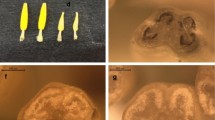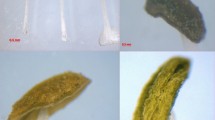Abstract
Cytoplasmic male sterile system in ridge gourd has been converted to cytoplasmic genetic male sterile (CGMS) system through the development of analogues of male sterile (MS) line, maintainer line and fertility restorer line. These lines were developed by crossing the MS mutant, regenerated through in vitro culture, with monoecious pollen parents Deepthi, Haritham, LA 101, CO 2, IC 92761 and IC 92685. All hybrids and the BC1 generation developed by crossing with the recurring pollen parents Deepthi, Haritham and LA 101 were male sterile. Male sterile BC1 plants have been advanced to BC6 generation and the parental line LA 101 was proved to be a successful maintainer line, producing male sterile progeny in successive back cross generations. Analogue of cytoplasmic male sterile line, MS LA 101, was developed through back crossing and on crossing with fertility restorer lines Arka Sumeet and LA 102, this line excelled as female parent, resulting heterotic combinations. Mitochondrial marker rpS14 and SCAR Tm-53 were identified to yield male sterility specific markers whereas SSR marker 18956 has generated the male fertility specific marker. These primers are recommended for marker assisted selection of ridge gourd, for utilizing male sterility for hybrid seed production and for developing A, B and C lines in CGMS system.





Similar content being viewed by others
References
Atanassova B, Georgiev H (2002) Using genic male sterility in improving hybrid seed production in tomato (Lycopersicon esculentum Mill.). Acta Hortic 579:185–188
Budar F, Pelletier G (2001) Male sterility in plants: occurrence, determinism, significance and use. Life Sci 324:543–550
Budar F, Touzet P, De Paepe R (2003) The nucleo-mitochondrial conflict in cytoplasmic male sterilities revisited. Genetica 117:3–16
Carle RB (1997) Bisex sterility governed by a single recessive gene in Cucurbita pepo L. Cucurb Genet Coop Rep 20:46–47
Choudhary B, Thakur MR (1965) Inheritance of sex forms in Luffa. Indian J Genet Plant Breed 25:188–197
Dhatt AS, Gill SS (2000) Effect of genic male sterility on flowering behaviour of muskmelon. Veg Sci 27:31–34
Dyutin KE, Puchkov MYU (1996) New trends in breeding Cucurbita pepo of the marrow and custard types. Kartofel’ i Ovoshchi 5:25
Hanson MR, Sutton CA, Lu B (1996) Plant organelle gene expression: altered by RNA editing. Trends Plant Sci 1:57–64
Hariprasanna K, Zaman FU, Singh AK (2005) Identification of versatile fertility restorers genotype for diverse CMS lines of rice. Oryza 42:20–26
Hexun H, XiaoQi Z, ZhenCheng W, QingHuai L, Xi L (1998) Inheritance of male-sterility and dwarfism in watermelon [Citrullus lanatus (Thunb.) Matsum, Nakai]. Sci Hortic 74:174–181
Kamenetsky R, Rabinowitch HD (2002) Florogenesis. In: Rabinowitch HD, Currah L (eds) Allium crop sciences: recent advances. CABI, Wallingford, pp 31–57
KAU (2014) Package of practices recommendations: crops, 12th edn. Directorate of Extension. Kerala Agricultural University, Thrissur
Kempken F, Pring DR (1999) Plant breeding: male sterility in higher plants-fundamentals and applications. In: Esser K, Kadereit JW, Luttge U, Runge M (eds) Progress in botany, 60th edn. Springer, Berlin, pp 139–166 (ISSN: 0340-4773, ISBN 10: 3540646892)
Khera P, Priyadarshi A, Singh R, Mohan R, Gangashetti MG, Singh BN, Cole K, Shenoy V (2012) Molecular characterization of different cytoplasmic male sterile lines using mitochondrial DNA specific markers in rice. J Biol Sci 12:154–160
Murugan S, Ganesan J (2006) Pollen and spikelet fertility analysis in rice crosses involving WA cytosteriles. Int J Agric Sci 2:315–316
Park SO, Hwang HY, Crosby KM (2009) A genetic linkage map including loci for male sterility, sugars, and ascorbic acid in melon. J Am Soc Hortic Sci 134:67–76
Popova PKS, Dimaculangan D, Radkova M, Vulkova Z (2007) Towards cytoplasmic male sterility in cultivated tomato. J Agric Food Environ Sci 1:1–13
Pradeepkumar T, Sujatha R, Krishnaprasad BT, Johnkutty I (2007) New source of male sterility in ridge gourd [Luffa acutangula (L.) Roxb.] and its maintenance through in vitro culture. Cucurbit Genet Coop Rep 30:60–63
Pradeepkumar T, Hegde VC, Sujatha R, George TE (2010) Characterization and maintenance of novel source of male sterility in ridge gourd [Luffa acutangula (L.) Roxb.]. Curr Sci 99:1326–1327
Pradeepkumar T, Hegade VC, Kannan D, Sujatha R, George TE, Nirmaladevi S (2012) Inheritance of male sterility and presence of dominant fertility restorer gene in ridge gourd [Luffa acutangula (Roxb.) L.]. Sci Hortic 144:60–64
Roberts M, Boyes E, Scott R (1995) An investigation of the role of the anther tapetum during microspore development using genetic cell ablation. Sex Plant Reprod 8:299–307
Schnable PS, Wise RP (1998) The molecular basis of cytoplasmic male sterility and fertility restoration. Trends Plant Sci 3:175–180
Shengjun Z, Peng Z, Yuqiang Z, Xinjuan C, Liping C (2013) Identification of SSR marker linked to gynoecious loci in cucumber (Cucumis sativus L.). Zhejiang J Agric Sci 3:7
Sheshadri VS (1990) Cucurbits. In: Bose TK, Som MG (eds) Vegetable crops in India. Nayaprakash Publishers, Culcutta, pp 91–164
Stuber CW (1994) Heterosis in plant breeding. Plant Breed Rev 12:25–227
YanPing Z, HaiHe L, Bin X, ShouPeng G (2010) mRNA differential display between the male sterile buds and male fertile buds in watermelon male sterile G17AB line. J Fruit Sci 27:1037–1041
Zhang Q, Gabert AC, Baggett JR (1994) Characterizing a cucumber pollen sterile mutant: inheritance, allelism, and response to chemical and environmental factors. J Am Soc Hortic Sci 119:804–807
Acknowledgements
We are grateful to the Kerala Agricultural University for providing fund for undertaking this investigation as part of the state plan project sponsored by Govt. of Kerala.
Author information
Authors and Affiliations
Corresponding author
Rights and permissions
About this article
Cite this article
Pradeepkumar, T., Minimol, J.S., Mathew, D. et al. Development of CGMS system in ridge gourd [Luffa acutangula (Roxb.) L.] for production of F1 hybrids. Euphytica 214, 159 (2018). https://doi.org/10.1007/s10681-018-2240-1
Received:
Accepted:
Published:
DOI: https://doi.org/10.1007/s10681-018-2240-1




